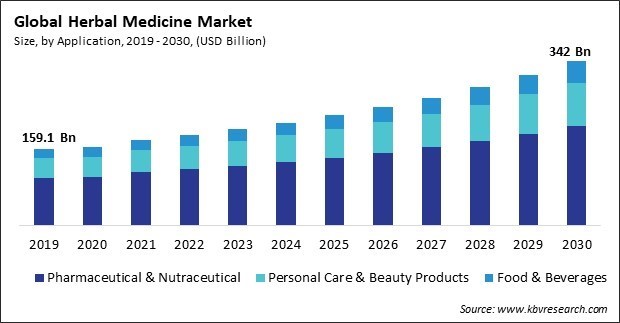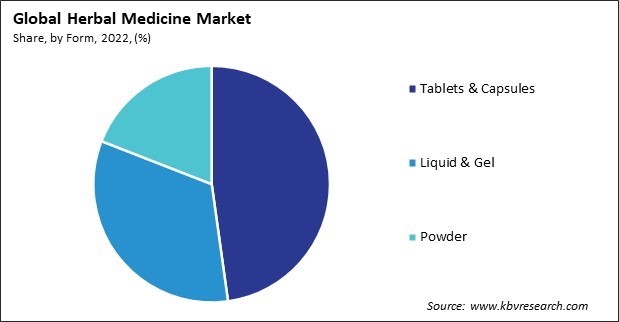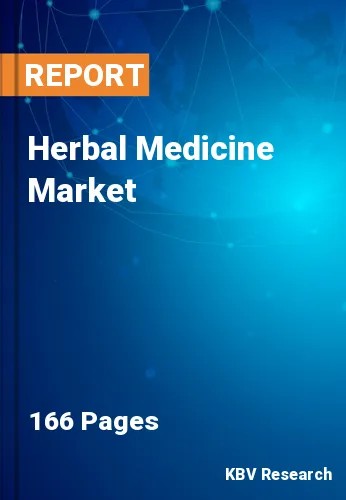“Global Herbal Medicine Market to reach a market value of USD 342 Billion by 2030 growing at a CAGR of 7.9%”
The Global Herbal Medicine Market size is expected to reach $342 billion by 2030, rising at a market growth of 7.9% CAGR during the forecast period.
In North America, particularly in the U.S., there is growing consumer awareness about health and a shift in attitudes toward natural care products due to a strong environmental consciousness. Consequently, the North America region captured $53,058.8 million revenue in the market in 2022. This shift is attributed to concerns about the potential harmful effects of alternative medicines on individuals' health. Increasingly, more customers, mostly in the U.S., are concerned about their health, and a strong green wave has caused a change in the public's perception of natural healthcare products. The alleged detrimental impacts of alternative medicines on people's health are to blame for this.

Consumers are increasingly inclined towards natural remedies and plant-based solutions. The awareness that these medicines are derived from botanical sources and often have a long history of traditional use contributes to the growing preference for these remedies over synthetic drugs. These medicines are known for their holistic approach to health, addressing the symptoms and underlying causes of health issues. Additionally, the perception that natural and plant-based remedies are inherently safer than synthetic drugs are a key driver. Consumers, increasingly concerned about pharmaceuticals' potential side effects and long-term impact, are drawn to these medicines for their perceived safety profile. Consumers have access to a wealth of information about the benefits of specific herbs, empowering them to make informed decisions in favor of natural solutions. Therefore, the growing preference for natural and plant-based solutions is a powerful driver behind the expansion of the market.
Furthermore, COVID-19 had a moderate impact on the market. The market relies heavily on sourcing raw materials from diverse geographical regions. The disruptions caused by lockdowns, travel restrictions, and logistical challenges during the pandemic have significantly impacted the supply chain. The manufacturers faced delays in procuring essential botanicals, affecting production timelines and inventory levels. The heightened awareness of health and wellness during the pandemic had increased the demand for immune-boosting products, including herbal remedies. Consumers had sought natural alternatives to support their immune systems, leading to a wave in sales of herbal supplements, teas, and formulations designed to enhance overall well-being. E-commerce platforms became crucial channels for reaching consumers directly, fostering a digital transformation within the market. As a result, due to these changes, the market is expected to grow significantly in the coming years.
However, lack of education about these medicines may lead to safety concerns and misuse. Customers may not be aware of possible interactions with medications or may not follow proper dosage instructions, leading to adverse effects and safety issues. Misperceptions about the efficacy and safety of herbal remedies can erode trust in these products. Without proper education, consumers may view these medicines as unproven or ineffective, hindering their willingness to incorporate them into their healthcare routines. The market may see inconsistent demand, with consumers choosing products based on marketing rather than clearly understanding their health needs. Also, the lack of education about herbal medicine among consumers may result in resistance from healthcare professionals. If patients are not adequately informed about herbal remedies, healthcare providers may be skeptical or hesitant to support their integration into treatment plans. Due to the above factors, market growth will be hampered in the coming years.
Based on form, the market is fragmented into powder, liquid & gel, and tablets & capsules. In 2022, the tablets & capsules segment held the highest revenue share in the market. Tablets and capsules allow for precise dosage standardization, ensuring each unit contains consistent active herbal ingredients. This standardization is crucial for maintaining efficacy and safety, providing consumers with reliable and predictable dosages. Tablets and capsules offer a solution by masking the taste and smell of herbal ingredients, making them more palatable for those who may find the natural flavors objectionable. The encapsulation or compression process protects the herbal ingredients from exposure to light, air, and moisture, helping to preserve their potency over time. This prolonged stability is beneficial for both manufacturers and consumers.

On the basis of application, the market is segmented into pharmaceutical & nutraceutical, food & beverages, personal care & beauty products. The food & beverages segment acquired a substantial revenue share in the market in 2022. One of the most prevalent uses of these medicines in the food and beverage industry is the creation of herbal infusions and teas. The rise of functional beverages has led to incorporating herbal extracts and botanicals in drinks designed to provide specific health benefits. Beverages such as herbal tonics, wellness shots, and elixirs are formulated with herbs known for their adaptogenic, antioxidant, or anti-inflammatory properties, offering consumers a refreshing way to support their well-being.
Free Valuable Insights: Global Herbal Medicine Market size to reach USD 342 Billion by 2030
Region-wise, the market is analysed across North America, Europe, Asia Pacific, and LAMEA. In 2022, the Europe region witnessed the largest revenue share in the market. Europe boasts the world's largest cosmetics industry, promising opportunities for newcomers from developing countries. The personal care and beauty product segment is witnessing a growing demand for natural ingredients, a trend expected to persist. Europe is anticipated to significantly contribute to future market growth by catering to this demand. Turmeric is gaining popularity in the European health products market and is recognized for its antioxidant and anti-inflammatory properties. It is utilized as a supplement and in medical products to enhance the immune and digestive systems and overall health.
| Report Attribute | Details |
|---|---|
| Market size value in 2022 | USD 188.8 Billion |
| Market size forecast in 2030 | USD 342 Billion |
| Base Year | 2022 |
| Historical Period | 2019 to 2021 |
| Forecast Period | 2023 to 2030 |
| Revenue Growth Rate | CAGR of 7.9% from 2023 to 2030 |
| Number of Pages | 166 |
| Number of Tables | 260 |
| Report coverage | Market Trends, Revenue Estimation and Forecast, Segmentation Analysis, Regional and Country Breakdown, Porter’s 5 Forces Analysis, Company Profiling, Companies Strategic Developments, SWOT Analysis, Winning Imperatives |
| Segments covered | Form, Application, Region |
| Country scope |
|
| Companies Included | Herbalife nutrition Ltd., Blackmores Limited (Kirin Holdings Company, Limited), Himalaya Global Holdings Ltd., Nutraceutical Corporation, Patanjali Ayurved Limited, Genius Nature Herbs Private Limited, Bio-Botanica, Inc., 21ST Century HealthCare, Inc., Emami Limited and Cultivator Natural Products Pvt. Ltd. |
By Application
By Form
By Geography
The Market size is projected to reach USD $342 billion by 2030.
Growing preference for natural and plant-based solutions are driving the Market in coming years, however, Limited scientific evidence and research restraints the growth of the Market.
Herbalife nutrition Ltd., Blackmores Limited (Kirin Holdings Company, Limited), Himalaya Global Holdings Ltd., Nutraceutical Corporation, Patanjali Ayurved Limited, Genius Nature Herbs Private Limited, Bio-Botanica, Inc., 21ST Century HealthCare, Inc., Emami Limited and Cultivator Natural Products Pvt. Ltd.
The expected CAGR of this Market is 7.9% from 2023 to 2030.
The Pharmaceutical & Nutraceutical segment is leading the Market by Application in 2022; thereby, achieving a market value of $206.8 billion by 2030.
The Europe region dominated the Market by Region in 2022, and would continue to be a dominant market till 2030; thereby, achieving a market value of $111.9 billion by 2030.
Our team of dedicated experts can provide you with attractive expansion opportunities for your business.

 Drivers
Drivers
 Restraints
Restraints
